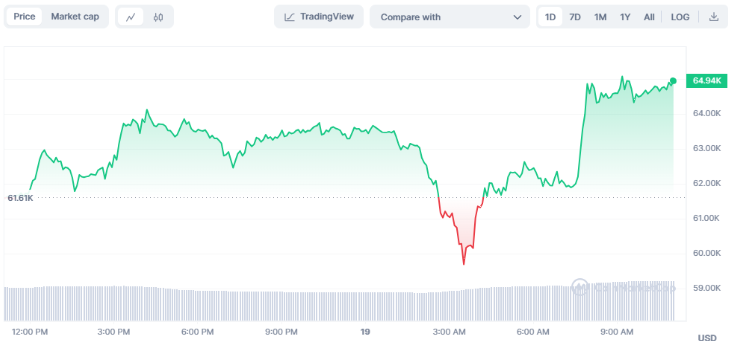The highly anticipated fourth halving event for Bitcoin is on the verge of unfolding, slated to take place shortly after midnight UTC on April 20, with the corresponding time in Eastern Time being 8 pm today. This event marks a significant milestone in Bitcoin’s monetary policy, as it triggers a reduction in the block subsidy reward for miners from 6.25 BTC to 3.125 BTC per block. The implications of this adjustment have the potential to reverberate across the cryptocurrency landscape, influencing both the price of Bitcoin and the operations of mining activities.
Bitcoin halvings are ingrained in the protocol’s design and occur automatically every 210,000 blocks, which roughly translates to an interval of four years. This mechanism serves as a fundamental component of Bitcoin’s deflationary monetary policy, aiming to gradually reduce the rate at which new bitcoins are introduced into circulation. By periodically halving the block subsidy reward, Bitcoin’s supply issuance is meticulously controlled, ultimately leading to a capped supply of 21 million bitcoins.
To grasp the significance of the upcoming halving event, it is instructive to examine the historical impact of previous halvings on the cryptocurrency industry. Historically, Bitcoin halvings have been accompanied by periods of heightened market volatility and speculation, as market participants anticipate the potential effects on supply and demand dynamics. Previous halving events have often catalyzed bullish sentiment, leading to surges in the price of Bitcoin as investors interpret the reduction in supply issuance as a bullish catalyst.
Beyond price dynamics, halving events also exert profound effects on the mining ecosystem. The reduction in block rewards directly impacts the profitability of mining operations, prompting adjustments in miners’ strategies and equipment upgrades to maintain competitiveness. Consequently, halving events often precipitate shifts in hash rate distribution and mining difficulty as miners adapt to the altered economic incentives.
Let’s take a retrospective glance at past Bitcoin halving occurrences.
Bitcoin halving events have emerged as pivotal milestones in the cryptocurrency’s journey, often heralding major price rallies and underscoring its increasing adoption and potential. Bitcoin’s protocol has mandated three halving events thus far, each representing a significant reduction in the block reward for miners.
The first halving occurred in 2012, precipitating a reduction in the block reward from 50 BTC to 25 BTC. This historic event marked a crucial juncture in Bitcoin’s monetary policy, highlighting its deflationary nature and the diminishing rate of new coin issuance.
Subsequently, in 2016, Bitcoin experienced its second halving, further reducing the block reward to 12.5 BTC. This event underscored the protocol’s predetermined supply schedule and reinforced Bitcoin’s scarcity narrative, fueling anticipation and speculation within the cryptocurrency community.
Most recently, on May 11, 2020, Bitcoin underwent its third halving, halving the block reward to 6.25 BTC. This event garnered significant attention from investors and industry observers alike, with many anticipating its potential impact on the price dynamics of Bitcoin and the broader cryptocurrency market.
Looking ahead, the upcoming halving event in 2024 will see the subsidy reward for miners on the Bitcoin network drop from 6.25 BTC to 3.125 BTC per block. This reduction in block rewards underscores Bitcoin’s gradual transition toward its maximum supply of 21 million coins, highlighting its inherent scarcity and the finite nature of its monetary supply.
In the long term, the fixed supply of 21 million Bitcoins serves as a foundational tenet of Bitcoin’s value proposition, distinguishing it from traditional fiat currencies subject to inflationary pressures. This scarcity narrative has played a central role in shaping investor perceptions and driving demand for Bitcoin as a store of value and hedge against inflationary risks.
As Bitcoin’s halving events continue to unfold, they serve as critical moments of reflection for the cryptocurrency ecosystem, underscoring the protocol’s resilience, its adherence to predetermined monetary policies, and its enduring relevance within the broader landscape of digital assets.
What lies ahead post-2024’s Halving Event?
Bernstein forecasts that Bitcoin will maintain its bullish trajectory following the halving event, potentially surging to $150,000 by the conclusion of 2025.
Yet, Rikke Staer from Coinify holds a contrasting view, suggesting that the halving event could prompt a “sell-the-news” response, particularly as less efficient miners may need to offload their existing BTC holdings, potentially generating sell pressure.
Although Bitcoin miners have enjoyed profitability this year, the precise ramifications of the halving on less efficient mining operations remain uncertain.

As of the latest update, Bitcoin’s price is approximately $64,500, indicating a modest increase of 1.33% within the past 24 hours, according to data sourced from CoinMarketCap.
Earlier today, Bitcoin experienced a temporary decline, dipping below the $60,000 mark. This downward movement coincided with reports of Israeli missiles striking a site in Iran, triggering geopolitical tensions and prompting market volatility. However, Bitcoin swiftly rebounded from this initial dip, demonstrating resilience in the face of external geopolitical events.
The ability of Bitcoin to recover and rebound strongly from intraday fluctuations underscores the cryptocurrency’s robustness and its status as a global asset class unaffected by localized geopolitical developments. Despite momentary fluctuations driven by external factors, Bitcoin continues to attract investors and maintain its upward trajectory, buoyed by growing adoption and institutional interest.
As Bitcoin continues to navigate the dynamic landscape of global markets, investors and analysts closely monitor price movements and external events for insights into the cryptocurrency’s future trajectory. Amidst ongoing geopolitical uncertainties and market volatility, Bitcoin’s ability to weather short-term fluctuations reaffirms its status as a resilient and enduring digital asset with significant long-term potential.
READ MORE ABOUT: According to analysts at Bernstein, Bitcoin is predicted to surge to new all-time highs fueled by rallies driven by ETFs.



